There are four famous cultural things in China according to our guide. Calligraphy, majong, opera, and acupuncture. I thought that list was quite short remembering their lions, the abacus, their dragons, lanterns, and myriad other fascinating things we see in our travels. In any case, Beijing has the traditional Opera. But, first, the Summer Palace.

It is October of 2006, and it rained a bit the morning of our visit. We spot this imposing building from the bus as it sits next to the river. Our guide tells us this will be our only chance to catch a picture of the entire building, which we obediently do.

There may be other ways to get to the Summer Palace but we are treated to a ferry ride across the lake in a replica of a boat used in the days of Empress Cixi, (pronounced Sissy-putz.)
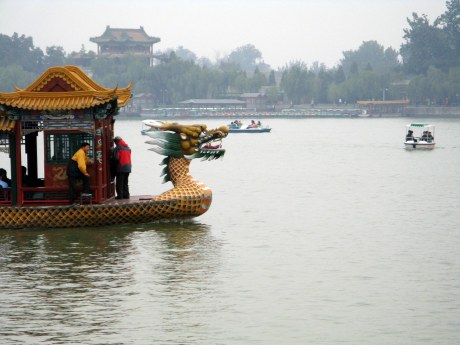
The lake has both modern and replica dragon boats plying tourists around the lake to support china’s newly burgeoning tourist market.
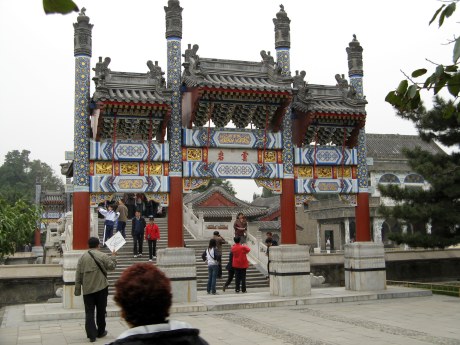
We enter the palace grounds through this exquisite gate.
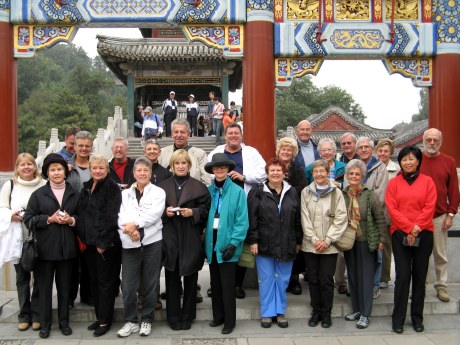
Our group pauses for a picture.
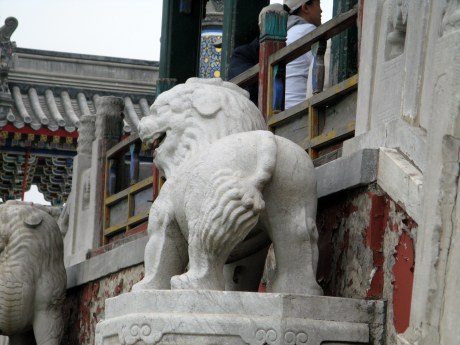
As we cross over the bridge, I see the lions guarding us and notice the peeling paint. (It will be gone soon.) The Dragon Lady Empress Dowager used the Summer Palace, which is the largest royal garden preserved in China. The royal empresses of old were confined to their “Peaceful Garden” and Long Hall, which is not a “hall” but beautifully decorated covered walkways with many benches for resting because of their bound feet.

The wooden ceiling of this covered walkway is beautifully painted. And, about every ten feet or so is a painting like this one for her to enjoy. This walkway is probably a half mile long with many benches for the Empress to sit and rest her feet.

Her guests would be entertained at a banquet on a marble boat in the Grand Canal as though they were traveling to some exotic place. In 2006 I had a brand new digital camera and didn’t use it to much advantage. The marble boat, which obviously didn’t float is in the background of this photo. We were not allowed on the boat.

A majestic lion guards every corner of the bridge and smaller ones decorate each bridge support.

We walked all over the area and enjoyed this beautiful park. One of the buildings, the “Big Hall” is reserved for visiting dignitaries and is still used by the government in that way. The Empress’ personal quarters were not open to the public as the Summer Palace is undergoing refurbishment in readiness for the first ever Olympics to be held in China.
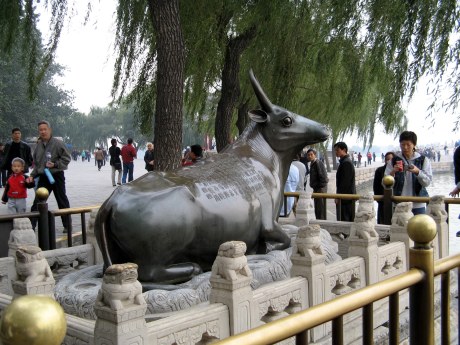
We did not learn the significance of this carved ox because everything was written in script. Our guide told us that before the Olympics, all signage will be printed in other languages for the benefit of tourists.

People on the street don’t seem to like having you take their picture. I surreptitiously caught this Chinese worker carrying her thermos? The brooms they use seem quite crude but they do the job. Workers are distinguished by their deep blue costumes.
Lunch was a typical Chinese “private”, meaning not government owned, restaurant. The best food so far with great sea weed, cabbage, always bok choy, chicken, beef, cucumbers, soup, little meaty hors’ duevres. Meat is always small quantities with many vegetables and usually a tasty sauce and rice that is traditionally served last. It is only to fill you up if you didn’t get enough of the primary foods. We all asked for our rice with our meal the way we are used to it and, of course, we are accommodated.
At lunch, Vicki, our guide, explained that her own grandmother had bound feet, the cruel tortuous practice instigated by the Emperor’s favorite concubine who had tiny, tiny feet. He considered them so beautiful and dainty that aristocratic women made their own daughters emulate that identified “beauty” by binding their feet. Vicky called it, “Five hundred years of cruelty and crippling of women.” Her grandparents were “political”, meaning outspoken and were banished to the high country of China near Tibet, but Vicky remembers her painful feet.

It is October of 2006, and it rained a bit the morning of our visit. We spot this imposing building from the bus as it sits next to the river. Our guide tells us this will be our only chance to catch a picture of the entire building, which we obediently do.

There may be other ways to get to the Summer Palace but we are treated to a ferry ride across the lake in a replica of a boat used in the days of Empress Cixi, (pronounced Sissy-putz.)

The lake has both modern and replica dragon boats plying tourists around the lake to support china’s newly burgeoning tourist market.

We enter the palace grounds through this exquisite gate.

Our group pauses for a picture.

As we cross over the bridge, I see the lions guarding us and notice the peeling paint. (It will be gone soon.) The Dragon Lady Empress Dowager used the Summer Palace, which is the largest royal garden preserved in China. The royal empresses of old were confined to their “Peaceful Garden” and Long Hall, which is not a “hall” but beautifully decorated covered walkways with many benches for resting because of their bound feet.

The wooden ceiling of this covered walkway is beautifully painted. And, about every ten feet or so is a painting like this one for her to enjoy. This walkway is probably a half mile long with many benches for the Empress to sit and rest her feet.

Her guests would be entertained at a banquet on a marble boat in the Grand Canal as though they were traveling to some exotic place. In 2006 I had a brand new digital camera and didn’t use it to much advantage. The marble boat, which obviously didn’t float is in the background of this photo. We were not allowed on the boat.

A majestic lion guards every corner of the bridge and smaller ones decorate each bridge support.

We walked all over the area and enjoyed this beautiful park. One of the buildings, the “Big Hall” is reserved for visiting dignitaries and is still used by the government in that way. The Empress’ personal quarters were not open to the public as the Summer Palace is undergoing refurbishment in readiness for the first ever Olympics to be held in China.

We did not learn the significance of this carved ox because everything was written in script. Our guide told us that before the Olympics, all signage will be printed in other languages for the benefit of tourists.

People on the street don’t seem to like having you take their picture. I surreptitiously caught this Chinese worker carrying her thermos? The brooms they use seem quite crude but they do the job. Workers are distinguished by their deep blue costumes.
Lunch was a typical Chinese “private”, meaning not government owned, restaurant. The best food so far with great sea weed, cabbage, always bok choy, chicken, beef, cucumbers, soup, little meaty hors’ duevres. Meat is always small quantities with many vegetables and usually a tasty sauce and rice that is traditionally served last. It is only to fill you up if you didn’t get enough of the primary foods. We all asked for our rice with our meal the way we are used to it and, of course, we are accommodated.
At lunch, Vicki, our guide, explained that her own grandmother had bound feet, the cruel tortuous practice instigated by the Emperor’s favorite concubine who had tiny, tiny feet. He considered them so beautiful and dainty that aristocratic women made their own daughters emulate that identified “beauty” by binding their feet. Vicky called it, “Five hundred years of cruelty and crippling of women.” Her grandparents were “political”, meaning outspoken and were banished to the high country of China near Tibet, but Vicky remembers her painful feet.
3 comments:
find more infoarticle source his comment is hereclick here to find out more Get More Infoclick to investigate
about his blog link Our site site web official website louis vuitton replica
Post a Comment